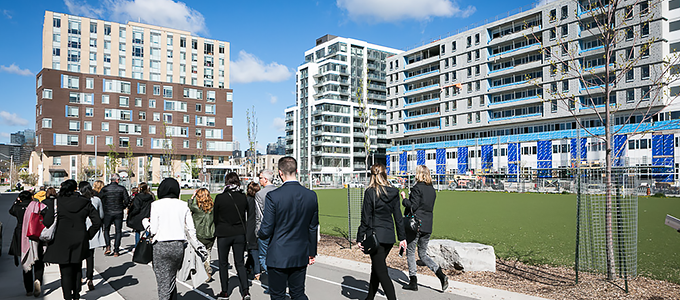A couple of years ago, when my daughter was applying to college, Forbes magazine came out with a new college ranking system based on graduates’ salaries, and debates swirled about the ROI of a liberal arts vs. a pre-professional education. Many blasted the former as impractical and anachronistic, while others believed that without arts and humanities, schools might as well be churning out robots. I remember thinking that both arguments missed the point, because they should not be mutually exclusive. After all, becoming a successful doctor, engineer, or interior designer requires both technical training as well as an understanding of our place in this world and how to relate to each other.
This debate was on my mind last month when I attended the second Impact Summit in Toronto. Co-hosted by ASID and IDC, the Interior Designers of Canada, the goal of these Summits is to explore the impact of design on global issues. This year’s topic was “Migration, Culture, and Diversity in the Built Environment” and it was attended by interior designers, educators, researchers, architects, city planners, and business leaders who were all interested in how design can help immigrants assimilate, refugees heal, and multicultural communities thrive.
It was a far cry from the “how to” lunch & learns I’m used to, or even the case studies and the educational trend discussions I love to attend at Neocon. The Impact Summit was a completely different story; attending it gave me hope that as an interior designer, I can actually make a difference in helping to solve some of the distressing and seemingly overwhelming problems facing the world today.
Here are some of the highlights:
A tour of the newly redeveloped Regent Park, a formerly dangerous and blighted area of Toronto that now celebrates diversity in age, culture, race, income level, etc. It was an inspiring example of public-private partnerships and how design at all different scales can change the daily lives of individuals.
A riveting keynote by the Honorable Ratna Omidvar, Senator for the province of Ontario. A former educator from India married to an Iranian who both came to Canada in 1981, Senator Omidvar shared many pearls of wisdom, including her view of statistical diversity: that 1 in 10 is seen as a token, 2 in 10 as an interest group, and only when we reach 3 in 10 do we get true diversity.
A talk by the bold and charming Richard van der Laken, founder and creative director of the What Design Can Do conference on humanitarian design. A graphic designer by training, van der Laken believes that designers can tackle social and political problems that are too gnarly for governments to solve.
After each panel discussion, the panelists and attendees broke into small groups and together, devised realistic, tangible recommendations and action steps to take back to our communities. Later this summer, ASID will publish a whitepaper summarizing each group’s work, so stay tuned!
Believe me, I know first-hand how hard (and expensive) it is to unplug and attend an out-of-town conference. But just as CIDA accredited programs require general education courses as part of their curricula, true continuing education needs to go beyond “how to” CEUs and actually hone our ability to think critically. We need to change the lens with which we view design and expand the ways in which we relate to others, at home and around the world; attending these “liberal arts” type events is one way that helps me do so. See you at the next Impact Summit!




